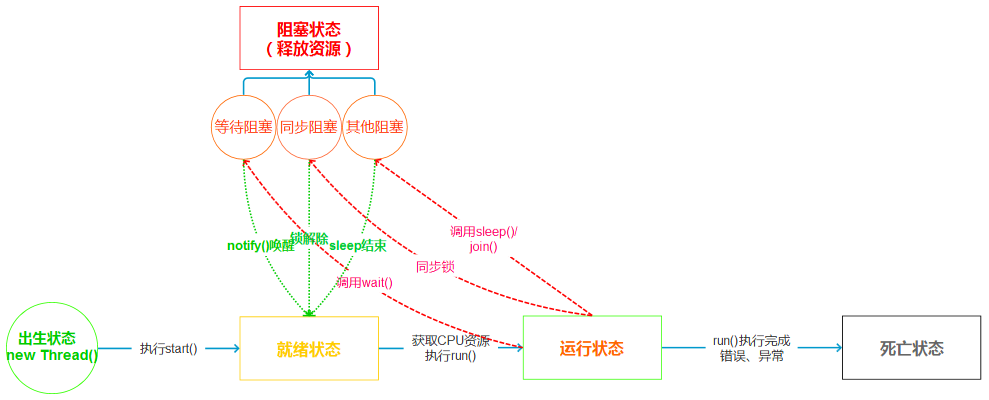学习内容:
进程与线程:进程是一个单独运行的程序,有自己的资源与内存,线程是在进程内部同时做的事情,一个进程可以有一个或多个线程,而一个线程只能有一个进程。
多线程:多线程简单来说就是在同一时间执行多个方法。
一般情况下,在main方法内调用的方法会依次执行,一次只能执行一个,因为只有一个main线程(主线程)。
1.多线程有三种实现方式:
(1)继承Thread类,重写run方法,注意,这里重写的run方法时Runnable接口提供的抽象方法,因为Thread类也实现了Runnable接口
public class Test extends Thread{ @Override public void run() { for(int i=0;i<5;i++) { System.out.println("线程正在运行"+i); } } public static void main(String[] args) { Test t = new Test(); t.start(); for(int i=0;i<5;i++) { System.out.println("main线程正在执行"+i); } } }
(2)实现Runnable接口,重写run方法
这种方式耦合度更低:
public class Test implements Runnable{//耦合度更低,开启线程与run方法调用分离 @Override public void run() { for(int i=0;i<10;i++) { System.out.println(Thread.currentThread().getName()+"正在执行"+i); } } public static void main(String[] args) { Test t = new Test(); new Thread(t).start();//将实现runnable接口的类对象传入,最终调用的是t的run方法 for(int i=0;i<10;i++) { System.out.println(Thread.currentThread().getName()+"正在执行"+i); } } }
(3)匿名类
public class Test { public static void function() { for(int i=0;i<1000;i++) { System.out.println(i); } } public static void main(String[] args) { Thread t1 = new Thread() { public void run() { function(); } }; t1.start(); Thread t2 = new Thread() { public void run() { for(int j=0;j<100;j++) { System.out.println(j+"s"); } } }; t2.start(); new Thread(new Runnable() { public void run() { } }) {}.start(); } }
区别:
继承Thread类:是通过该类被实例化的对象去调用start方法,利用start方法调用被重写的run方法,本质上是利用Thread类的子类调用了run方法。
继承Runnable接口:是实例化一个Runnable的实现类,然后通过实例化一个Thread对象,先调用Thread类的start方法,然后通过调用Thread类的run方法,间接调用Runnable实现类的run方法,真正的业务方法和调用类之间做了分离,耦合度更低。
2.常用方法:
currentThread() 获取当前线程,返回Thread
getName() 获取线程名
sleep(毫秒值) 线程休眠一段时间,时间到后继续执行,必须进行try catch
wait() 线程等待,直到被notify
notify() 唤醒等待线程
notifyAll() 唤醒所有等待线程
利用sleep()做一个简单的时钟:
import java.text.SimpleDateFormat; import java.util.Date; public class Clock implements Runnable{ @Override public void run() { while(true) { SimpleDateFormat sdf = new SimpleDateFormat("yyyy年MM月dd日 HH:mm:ss"); try { Thread.sleep(1000); String clock = sdf.format(new Date(System.currentTimeMillis())); System.out.println(clock); } catch (Exception e) { e.printStackTrace(); } } } } public class TestClock { public static void main(String[] args) { Clock c = new Clock(); new Thread(c).start(); } }
3.线程池
线程池的原理:创造一个容器,添加多个线程,使用线程时取出一个线程,使用完毕后再添加回线程池。
线程工厂类:Executors(JDK1.5)
public class ThreadPool { public static void main(String[] args) { ExecutorService service = Executors.newFixedThreadPool(2);//新建一个线程池,容量为2//销毁线程池 service.shutdown(); } }
使用方式:
(1)实现Runable接口,重写run方法
public class Run implements Runnable{ @Override public void run() { for(int i=0;i<5;i++) { System.out.println(Thread.currentThread().getName()+"正在运行:"+i); } } } public class ThreadPool { public static void main(String[] args) { ExecutorService service = Executors.newFixedThreadPool(2);//新建一个线程池 Run r = new Run(); service.submit(r);//添加线程对象 service.submit(r); } }
(2)实现Callable接口,重写call方法,注意,Callable接口有泛型,call方法有返回值
public class Call implements Callable<String>{ @Override public String call() throws Exception { return "abc"; } } public class ThreadPool { public static void main(String[] args) { ExecutorService service = Executors.newFixedThreadPool(2); Call c = new Call(); Future<String> f = service.submit(c);//接收返回值 try { System.out.println(f.get()); } catch (Exception e) { e.printStackTrace(); } } }
4.线程状态以及状态间的关系
线程分为五种状态:
- 新建状态:
使用 new 关键字和 Thread 类或其子类建立一个线程对象后,该线程对象就处于新建状态。它保持这个状态直到程序 start() 这个线程。
- 就绪状态:
当线程对象调用了start()方法之后,该线程就进入就绪状态。就绪状态的线程处于就绪队列中,要等待JVM里线程调度器的调度。
- 运行状态:
如果就绪状态的线程获取 CPU 资源,就可以执行 run(),此时线程便处于运行状态。处于运行状态的线程最为复杂,它可以变为阻塞状态、就绪状态和死亡状态。
- 阻塞状态:
如果一个线程执行了sleep(睡眠)、suspend(挂起)等方法,失去所占用资源之后,该线程就从运行状态进入阻塞状态。在睡眠时间已到或获得设备资源后可以重新进入就绪状态。可以分为三种:
-
等待阻塞:运行状态中的线程执行 wait() 方法,使线程进入到等待阻塞状态。
-
同步阻塞:线程在获取 synchronized 同步锁失败(因为同步锁被其他线程占用)。
-
其他阻塞:通过调用线程的 sleep() 或 join() 发出了 I/O 请求时,线程就会进入到阻塞状态。当sleep() 状态超时,join() 等待线程终止或超时,或者 I/O 处理完毕,线程重新转入就绪状态。
-
- 死亡状态:
一个运行状态的线程完成任务或者其他终止条件发生时,该线程就切换到终止状态。
